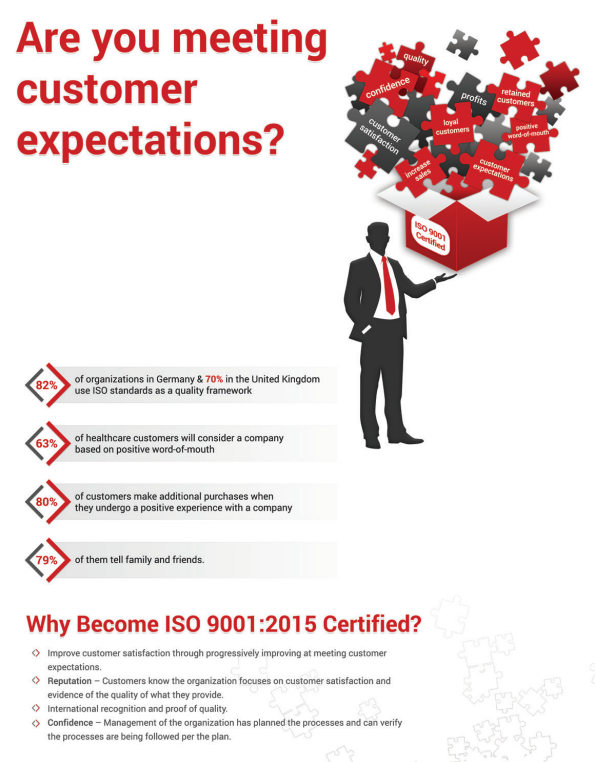Nowadays, quality is a word very often heard and spoken by society and industries of all sorts. Almost all organizations- product or service based- have some kind of advertisement signaling towards their company providing quality to the customer.
Apple portrays innovative technology with simplicity and quality design, BMW confirms its high-quality manufacturing and Hilton Hotel illustrations its top-notch quality service. Since, the meaning of quality comes down to the how well the features and characteristics of a product or service have the ability to satisfy identified needs, in other words, “customer satisfaction”.
Customer Satisfaction & Expectations
Customer satisfaction is another strong word in the business world. Satisfying your customer is converting first-time clients into loyal ones, growing from positive word-of-mouth advertisement and increased sales coming to fruition for the company. Apple, BMW, and Hilton and other businesses advertise their pursuit of customer satisfaction. Achieving customer satisfaction means meeting customer expectations. If the customer gets what they are expecting, then they will be satisfied or vice-versa. Likewise, once their expectations are met, it is likely to have them return for another great experience with your product or service. Therefore, taking quality into the frontline of business operations, it can really have a chain effect on business efficiency and profits.
According to the ASQ Global State of Quality, 82% of organizations in Germany use ISO standards as a quality framework and 70% in the United Kingdom.
The Center for Media Research reveals that “poor customer service” costs companies $83 billion annually in the U.S. According to TeleTech Holdings Inc., a positive word-ofmouth has a great influence on consumer decision in using a company; it states that 63% of healthcare customers will consider a company based on positive word-ofmouth.
Nonetheless, based on a recent survey done by Accent Marketing services, 80% of customers make additional purchases when they undergo a positive experience with a company and 79% of them tell family and friends.
ISO 9001:2015
Great news, quality experts! ISO 9001:2015 is the new word for quality and confidence today. The implementation of this standard helps organizations be confident in their ability to consistently provide products and services that meet customer expectations and have a built framework for improving customer satisfaction. Revisions have occurred to the standard, but the purpose remains the same.
For organizations to be successful, they must know the customer’s expectations, implement the expectations, be confident while having evidence of those expectations being met, and have built monitoring and measuring points in the processes that force examination of the processes to look for ways to improve in meeting expectations. Businesses have to adapt to meet the growing needs of customers. Revisions of the standard occurred to encompass the changes in the field of quality.
The standard was revised to meet Annex SL which standardized how standards are written. This makes integration between ISO 9001, ISO 14001 and the other standards more seamless. The second reason for revision was to bring forward the concept of risk management into the standard. Risk Management is the science of studying the activities of an organization, determining potential consequences of these activities, and mitigating the risks to an acceptable or manageable level.
Context of the Organization
The first risk managed in the standard directly links to customer expectations. The revised standard requires determining the influences on the organization and preparing countermeasures within the organization to address these influences. Addressing the “context of the organization” includes determining customer expectations and preparing to meet them. Without understanding customer expectations and ensuring countermeasures are prepared in the organization, one cannot expect customer satisfaction.
Risk Management
The standard requires organizations to address the risk that products or services will not meet specifications and won’t be able to satisfy its customer. The implementation of an ISO 9001:2015 requires a quality management system which is process based and that addresses the risks of those processes not meeting the expectations of the interested parties identified in the “context of the organization” being addressed. It requires built in monitoring and measuring of the processes to ensure they are actively seeking information to improve the process. A successful and thriving business realizes what an effective QMS in an organization can generate.

Benefits of Certification
- Improve customer satisfaction through progressively improving at meeting customer expectations.
- Reputation – Customers know the organization focuses on customer satisfaction and evidence of the quality of what they provide.
- International recognition and proof of quality. Incorporating “customers are first” culture by constantly meeting their implied needs.
- Confidence – Management of the organization has planned the processes and can verify the processes are being followed per the plan.
While the standard never prescribes what to do to achieve quality and satisfaction, it becomes the framework for accomplishment.
“The first step in exceeding your customer’s expectations is to know those expectations.” – Roy Hollister Williams
Here at PECB, we are highly focused on customer satisfaction and we strive continuously to provide our clients the best industry services. PECB is a certification body for persons, management systems, and products on a wide range of international standards. As a global provider of training, examination, audit, and certification services, PECB offers its expertise in multiple fields, including ISO 9001:2015 courses.
For further information, please visit: https://pecb.com/en/education-and-certification-for-individuals/iso-9001
About the Authors:
Arta Limani is an Account Manager for Quality Management Systems at PECB. She is in charge of conducting market research while developing and providing information related to Quality management systems at PECB. If you have any questions, please do not hesitate to contact: marketing.qms@pecb.com.
Debra Hay Hampton is a certified Lead Auditor in Quality and Environmental Management Systems, a certified Management Consultant by Exemplar Global and a certified Quality Engineer. She has determined the best way to implement ISO 9001. If you have any questions, please do not hesitate to contact: debra@ce-q.com










